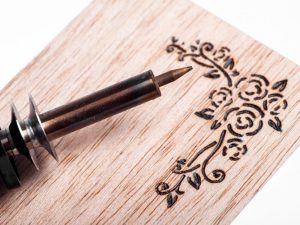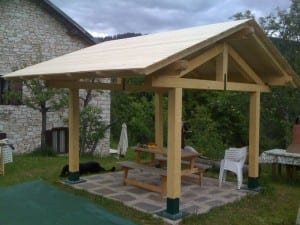Working on tough woodworking projects demands reliable support. Folding sawhorse plans offer a durable solution that folds away when not in use. These heavy-duty designs are built from robust lumber and reinforced hardware. You’re creating sawhorses that can handle heavy loads and rough conditions. This guide covers material selection, precise cutting, and assembly of portable supports.
Contents
Building Your Folding Sawhorse Plans
These steps guide you in assembling your folding sawhorses with precision and care. You’ll build strong supports that fold flat and store easily between jobs. Here is one of the heavy-duty folding sawhorse plans to build.
Materials & Tools Needed
- 2×4 lumber pieces cut to length
- Heavy-duty piano hinges (2)
- ¼″-20 carriage bolts with nuts (8)
- 3″ exterior wood screws (16)
- Power drill with bits
- Circular saw or miter saw
- Measuring tape and carpenter’s square
- Wood glue and pencil
- Safety glasses and work gloves
Steps:
- Lay out each pair of cut 2×4 legs and the matching cross braces on a flat work surface. Position braces about one third down from the top to form an A-frame.
- Apply wood glue to each brace end and clamp it between the legs. Drive two 3″ screws through each brace into the legs at a slight downward angle to prevent the wood from splitting.
- Pre-drill ¼″ holes along the top edge of each A-frame assembly. Space four holes evenly where the piano hinge will attach.
- Align a piano hinge along the pre-drilled edge of one A-frame. Secure it with carriage bolts and nuts but leave them finger-tight so the hinge can still pivot.
- Repeat hinge installation on the second A-frame assembly. Make sure the hinge barrels face the same direction so both sawhorses fold the same way.
- Open and close each sawhorse several times to test the folding action. Tighten any bolts that feel loose but keep the hinge able to move smoothly.
- Sand all rough edges and corners to prevent snags or splinters. Wipe away dust, then apply your choice of finish or sealant and let it dry fully before use.

Benefits of Folding Sawhorse Plans
Folding sawhorse plans offer many advantages for DIYers and professionals alike. They maximize workspace efficiency and improve convenience on and off the jobsite.
Space Efficiency
Designs fold flat to save floor space in small workshops and garages. You can store them against a wall or under a bench. They free room for larger projects and let you navigate crowded spaces safely.
Folding models slip into narrow gaps between shelving units and tool cabinets. When you need them again you pull them out in seconds. This compact design fits anywhere you need quick support without sacrificing workspace.
Versatility
You can use folding sawhorses for a range of projects. They adapt from simple wood cutting tasks to supporting power tools. Add a sheet of plywood across two for a portable workbench. Adjustable legs and braces let you handle materials of varying lengths.
They work as paint stands or scaffold supports on small jobs. You’ll use the same pair without extra equipment for household repairs or professional builds. You can customize them with clamps or vise attachments to expand their functionality.
Portability
These folding sawhorses collapse to a thin profile for transport. You’ll carry them easily to job sites or around your shop. Lightweight lumber and compact hinges reduce bulk and weight. They fit in the back of a pickup or sedan without requiring roof racks. Setup is fast because hinges open in seconds. Portability cuts downtime and boosts productivity on remote projects. You can store them in tight vehicle compartments or overhead racks when travelling between sites.
Cost-Effectiveness
Building folding sawhorses cuts expenses compared to buying commercial units. You’ll use scrap or affordable lumber and common hardware. Plans optimize cuts to minimize waste and lower material costs. Custom sizes mean you buy only what you need for your projects. Durable construction reduces the need for replacements. Plans are freely available online or in woodworking books to further cut costs. You can tailor hardware choices to fit any budget without sacrificing strength.
Reinforcing for Heavy-Duty Use
Reinforcing cross braces and plates boosts strength under heavy loads. You’ll upgrade your folding sawhorse plans to handle tough jobs without flex.
Gusset Plate Installation
Gusset plates fit between each leg and the top beam. They prevent shifting under load. You’ll cut plywood or metal plates to match the angle of your A-frame. Drill holes for mounting. Use carriage bolts and washers to secure plates on both sides.
Tight connections lock legs and braces in place for heavy-duty performance. This simple addition reduces wobble when hauling lumber or supporting power tools. Gusset reinforcement costs little and adds huge stability gains. It’s especially helpful for outdoor or shop use.
Cross-Brace Support
Cross braces connect the legs on each side diagonally. They resist side-to-side twisting. You’ll measure the gap between legs and cut 2×4 braces to fit snugly at a 45-degree angle. Apply glue and drive screws through the brace ends into the legs.
Ensure braces remain flush with the leg faces. This layout adds rigidity when cutting long boards. It also spreads forces for safer sawhorse operation. Cross-brace support fits inside or outside legs. You’ll notice less sway under load.
High-Strength Fasteners
Choosing the right fasteners is crucial for heavy loads. You’ll use grade-5 or stainless steel bolts for strength and corrosion resistance. Carriage bolts work well for hinge attachment and reinforcement plates.
Make sure the bolt length clears both boards and allows a locking nut. Washers distribute load and prevent pull-through. Tighten nuts until the joint is snug. Avoid overtightening to prevent crushing the wood fibers. Locking nuts or nylon inserts keep bolts secure over time.
Protective Coatings
Finishing your sawhorses protects wood from moisture and wear. You’ll apply outdoor-grade polyurethane or spar varnish for a durable barrier. Sand surfaces first for a smooth finish. Wipe away dust before coating.
Apply at least two thin coats with a brush. Allow proper drying time between coats to avoid tackiness. A clear finish preserves wood grain. You can also paint them with exterior latex paint for added resistance.
Installing Hinges and Folding Mechanism
Folding hinges let your sawhorses collapse flat for transport. Correct hinge mounting ensures smooth operation and lasting durability with ease in any conditions.
Aligning Hinge Centers
Aligning hinge centers is the first step. Use a square and pencil to mark the midpoint of each top beam. Transfer the center line to both A-frame assemblies. This alignment keeps sawhorse legs even when folding. Clamp frames to hold them steady.
Place the hinge along the center line and check that both sides meet squarely when closed. Accurate alignment prevents binding or uneven folds during use.
Pre-Drilling Hinge Holes
Pre-drilling holes prevents wood splitting and guides screws or bolts. Choose a drill bit slightly smaller than the hinge fastener diameter. Mark each hinge hole location through the hinge leaf. Drill straight down at a consistent depth to ensure flush mounting.
Remove hinge and clean wood dust. This step makes attaching hardware easier and improves joint accuracy. It also reduces mounting stress for smoother folding action over time.

Selecting Durable Hardware
Hardware choice affects sawhorse longevity and performance. You’ll want heavy-duty piano or strap hinges rated for outdoor use. Stainless steel or galvanized steel resists rust in damp environments. Make sure hinge leaves match the sawhorse width.
Check weight capacity limits on packaging. Investing in quality hinges avoids premature wear or failure under heavy loads. You’ll notice a smoother fold and longer service life from durable hardware.
Fastening Hinges Securely
Position the hinge on the pre-drilled surface and insert bolts or screws loosely. Check alignment by folding and unfolding both assemblies. When everything lines up, tighten fasteners with a wrench or driver until snug.
Avoid overtightening to allow hinge rotation without binding. Use lock washers or nylon hex nuts to prevent loosening over repeated use. A well-fastened hinge keeps your folding sawhorse plans reliable job after job.
Testing Folding Action
After installation, open and close the sawhorses several times to confirm smooth motion. Look for any binding or uneven movement between frames. If you detect resistance, loosen the hinge bolts slightly and realign components. Then retighten and test again.
Add a drop of wax or light lubricant on the hinge barrel if needed. Testing ensures your sawhorses fold correctly and stand sturdy under heavy loads. It finalizes the assembly phase.
Testing Load Capacity
You need to verify your sawhorses can handle the intended weight. This step avoids accidents and ensures safe performance under demanding tasks.
Visual Inspection
Before loading heavy items you should inspect each joint and fastener. Check for cracks in the wood and loose bolts. Tighten any hardware that feels loose. Look for gaps in the gusset plates or braces. Catching flaws early prevents failures under load. Replace any damaged components before proceeding with weight tests.
Static Load Test
Place a known weight on the sawhorse crossbeam and let it rest for several minutes. You can use sandbags or stacked lumber. Watch for any sagging or movement in the frame. If the beam bends more than 1⁄4 inch you should reinforce it. Remove the weight and inspect for new cracks. Adjust your design before full use.
Incremental Weight Testing
Start with light loads and increase weight in stages of 20 pounds. Record how each sawhorse responds at each stage. Stop if you see significant deflection or hear creaking. This gradual approach pinpoints the safe working limit. It also helps you verify uniform performance across both sawhorses. Mark the maximum safe load on each beam for future reference.
Observing Joint Performance
Watch how hinges and brace connections behave under strain. Folding points should stay tight and move smoothly. If you spot any looseness you’ll need to tighten or replace fasteners. Look for wear marks on hinge barrels or bolt holes. Proper joint performance maintains stability and prevents sudden collapse during use.

Finishing Touches and Wood Protection
Finishing trims rough edges and adds durability to your sawhorses. The right wood protection guards against moisture damage and wear over time.
Sanding and Surface Prep
Start with 120-grit sandpaper and smooth all surfaces. You’ll work the wood until it feels consistently even. Pay special attention to edges and corners. Remove all sawdust with a tack cloth or damp rag. A clean, smooth surface ensures better adhesion of finishes. It also prevents splinters during handling.
Applying Sealants
Select an outdoor-grade sealant like spar varnish or exterior polyurethane. Stir the product gently to avoid bubbles. Use a quality brush and apply thin, even coats. Let each coat dry fully before lightly sanding with 220-grit paper. Wipe away dust between coats. You’ll usually need two to three coats for lasting protection.
Paint or Varnish Options
You can choose a tinted exterior paint or clear varnish. Paint offers color and UV protection. Varnish highlights the natural wood grain. Both options require the same prep work. Apply in mild weather to ensure proper curing. Follow manufacturer recommendations for dry times and recoat intervals.
Hardware Rust Protection
Wipe hinges and bolts with a light machine oil or paste wax. This barrier resists rust in damp or outdoor conditions. Reapply every six months for continued protection. You can also use a spray lubricant on moving parts for smoother action. Keeping hardware rust-free extends hinge life and preserves folding function.
Conclusion
Building your own folding sawhorse plans gives you reliable, portable support for every project. The design folds flat for quick storage and easy transport. You’ll use common lumber, sturdy hinges, and simple reinforcements for heavy-duty performance. Regular testing and maintenance keep your sawhorses safe and functional. These durable supports will serve your workshop needs for years to come.
A sturdy folding sawhorse lets you create a wide range of projects. Check out our woodworking ideas you can create as gifts.






